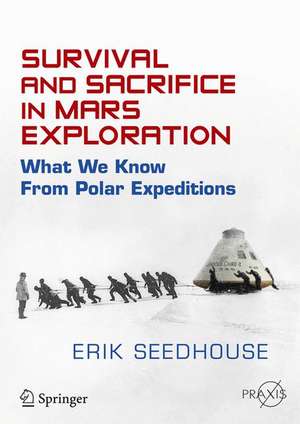Survival and Sacrifice in Mars Exploration: What We Know from Polar Expeditions: Springer Praxis Books
Autor Erik Seedhouseen Limba Engleză Paperback – 8 apr 2015
years. That’s a lot of time for things to go wrong. But sooner or later
a commercial enterprise will commit itself to sending humans to Mars.
How will the astronauts survive? Some things to consider are:
ith current technology, a voyage to Mars and back will take three years. That’s a lot of time for things to go wrong. But sooner or later
a commercial enterprise will commit itself to sending humans to Mars.
How will the astronauts survive? Some things to consider are:
• Who decides what medical resources are used for whom?
Who decides what medical resources are used for whom? • What is the relative weight of mission success and the health of the
crew?
What is the relative weight of mission success and the health of the crew?
• Do we allow crewmembers to sacrifi ce their lives for the good of the mission?
Do we allow crewmembers to sacrifi ce their lives for the good of the mission?
• And what if a crewmember does perish? Do we store the body for
return to Earth or give the member a burial in space?
Questions like these, and hundreds of others, have been explored by
science fi ction, but scant attention has been paid by those designing
missions. Fortunately, the experience gained in polar exploration more
than 100 years ago provides crews and mission planners with a framework
to deal with contingencies and it is this that forms the core of this book.
Why the parallels between polar and space exploration? Because polar
exploration offers a better analogy for a Mars mission today than those
invoked by the space community. Although astronauts are routinely
compared to Lewis and Clark, Mars-bound astronauts will be closer in their
roles to polar explorers. And, as much as space has been described as a
New Frontier, Mars bears greater similarity to the polar regions, which is
why so much can be learned from those who ventured there.
And what if a crewmember does perish? Do we store the body forreturn to Earth or givethe member a burial in space? Questions like these, and hundreds of others, have been explored by
science fi ction, but scant attention has been paid by those designing
missions. Fortunately, the experience gained in polar exploration more
than 100 years ago provides crews and mission planners with a framework
to deal with contingencies and it is this that forms the core of this book.
Why the parallels between polar and space exploration? Because polar
exploration offers a better analogy for a Mars mission today than those
invoked by the space community. Although astronauts are routinely
compared to Lewis and Clark, Mars-bound astronauts will be closer in their
roles to polar explorers. And, as much as space has been described as a
New Frontier, Mars bears greater similarity to the polar regions, which is
why so much can be learned from those who ventured there.
Din seria Springer Praxis Books
-
 Preț: 294.46 lei
Preț: 294.46 lei -
 Preț: 223.45 lei
Preț: 223.45 lei -
 Preț: 193.12 lei
Preț: 193.12 lei -
 Preț: 167.85 lei
Preț: 167.85 lei -
 Preț: 288.98 lei
Preț: 288.98 lei -
 Preț: 323.74 lei
Preț: 323.74 lei -
 Preț: 401.38 lei
Preț: 401.38 lei -
 Preț: 264.12 lei
Preț: 264.12 lei - 8%
 Preț: 513.00 lei
Preț: 513.00 lei -
 Preț: 190.01 lei
Preț: 190.01 lei -
 Preț: 218.16 lei
Preț: 218.16 lei -
 Preț: 312.06 lei
Preț: 312.06 lei - 17%
 Preț: 414.05 lei
Preț: 414.05 lei -
 Preț: 216.41 lei
Preț: 216.41 lei -
 Preț: 262.27 lei
Preț: 262.27 lei -
 Preț: 264.35 lei
Preț: 264.35 lei -
 Preț: 167.63 lei
Preț: 167.63 lei -
 Preț: 284.81 lei
Preț: 284.81 lei -
 Preț: 259.08 lei
Preț: 259.08 lei -
 Preț: 305.47 lei
Preț: 305.47 lei -
 Preț: 244.14 lei
Preț: 244.14 lei -
 Preț: 227.85 lei
Preț: 227.85 lei -
 Preț: 285.25 lei
Preț: 285.25 lei -
 Preț: 295.56 lei
Preț: 295.56 lei -
 Preț: 357.17 lei
Preț: 357.17 lei -
 Preț: 275.79 lei
Preț: 275.79 lei -
 Preț: 257.08 lei
Preț: 257.08 lei -
 Preț: 349.71 lei
Preț: 349.71 lei -
 Preț: 272.45 lei
Preț: 272.45 lei -
 Preț: 270.27 lei
Preț: 270.27 lei - 8%
 Preț: 456.51 lei
Preț: 456.51 lei -
 Preț: 352.34 lei
Preț: 352.34 lei - 8%
 Preț: 394.80 lei
Preț: 394.80 lei -
 Preț: 320.65 lei
Preț: 320.65 lei -
 Preț: 325.29 lei
Preț: 325.29 lei -
 Preț: 253.11 lei
Preț: 253.11 lei -
 Preț: 192.86 lei
Preț: 192.86 lei -
 Preț: 313.40 lei
Preț: 313.40 lei -
 Preț: 150.51 lei
Preț: 150.51 lei -
 Preț: 233.34 lei
Preț: 233.34 lei -
 Preț: 286.78 lei
Preț: 286.78 lei -
 Preț: 212.01 lei
Preț: 212.01 lei -
 Preț: 366.83 lei
Preț: 366.83 lei -
 Preț: 299.99 lei
Preț: 299.99 lei -
 Preț: 232.27 lei
Preț: 232.27 lei -
 Preț: 284.58 lei
Preț: 284.58 lei -
 Preț: 212.45 lei
Preț: 212.45 lei -
 Preț: 159.81 lei
Preț: 159.81 lei -
 Preț: 349.48 lei
Preț: 349.48 lei - 20%
 Preț: 2061.64 lei
Preț: 2061.64 lei
Preț: 265.56 lei
Nou
Puncte Express: 398
Preț estimativ în valută:
50.83€ • 54.86$ • 42.62£
50.83€ • 54.86$ • 42.62£
Carte tipărită la comandă
Livrare economică 19 aprilie-03 mai
Preluare comenzi: 021 569.72.76
Specificații
ISBN-13: 9783319124476
ISBN-10: 3319124471
Pagini: 300
Ilustrații: XXV, 163 p. 79 illus., 58 illus. in color.
Dimensiuni: 168 x 240 x 10 mm
Greutate: 0.31 kg
Ediția:2015
Editura: Springer International Publishing
Colecția Springer
Seriile Springer Praxis Books, Space Exploration
Locul publicării:Cham, Switzerland
ISBN-10: 3319124471
Pagini: 300
Ilustrații: XXV, 163 p. 79 illus., 58 illus. in color.
Dimensiuni: 168 x 240 x 10 mm
Greutate: 0.31 kg
Ediția:2015
Editura: Springer International Publishing
Colecția Springer
Seriile Springer Praxis Books, Space Exploration
Locul publicării:Cham, Switzerland
Public țintă
Popular/generalCuprins
Exploration Mission Architectures.- Expedition Leadership.- Bioethics.- Launch and Outbound.- Approach and Landing.- Surviving.- Sacrifice and Death.- Inbound.- Return.
Notă biografică
Erik Seedhouse is a Norwegian suborbital astronaut whose life-long ambition is to work in space. After completing a degree in Sports Science, the author joined the 2nd Battalion the Parachute Regiment. During his time in the “Para’s”, Erik spent six months in Belize, where he was trained in the art of jungle warfare. Later, he spent several months learning the intricacies of desert warfare in Cyprus. He made more than 30 jumps from a C130, performed more than 200 helicopter abseils, and fired more anti-tank weapons than he cares to remember!
Upon returning to the comparatively mundane world of academia, the author embarked upon a master’s degree in Medical Science, supporting his studies by winning prize money in 100-km running races. After placing third in the World 100 km Championships, the author turned to ultra-distance triathlon, winning the World Endurance Triathlon Championships in 1995 and 1996. For good measure, he won the World Double Ironman Championships and the Decatriathlon, an event requiring competitors to swim 38 km, cycle 1,800 km, and run 422 km. Non-stop!
Returning to academia, Erik pursued his Ph.D. at the German Space Agency’s Institute for Space Medicine. While studying, he won Ultraman Hawaii and the European Ultraman Championships, and completed Race Across America. As the world’s leading ultra-distance triathlete, Erik was featured in dozens of magazines and television interviews. In 1997, GQ magazine nominated him as the “Fittest Man in the World”.
In 1999, Erik retired from triathlon and started post-doctoral studies. In 2005, he worked as an astronaut training consultant for Bigelow Aerospace and wrote Tourists in Space. He is a Fellow of the BritishInterplanetary Society and a member of the Space Medical Association. In 2009, he was one of the final 30 candidates in the Canadian Space Agency’s Astronaut Recruitment Campaign. Erik works as a spaceflight instructor for the American Astronautics Institute, professional speaker, triathlon coach, author, and Editor-in-Chief for the Handbook of Life Support Systems for Spacecraft. He is the Training Director for Astronauts for Hire and, between 2008 and 2013, he served as director of Canada’s manned centrifuge operations.
In addition to being a suborbital astronaut, triathlete, centrifuge operator, pilot, and author, Erik is an avid mountaineer and is pursuing his goal of climbing the Seven Summits. Survival and Sacrifice is his seventeenth book. When not writing, he spends as much time as possible in Kona on the Big Island of Hawaii and at his real home in Sandefjord, Norway. Erik and his wife, Doina, are owned by three rambunctious cats – Jasper, Mini-Mach, and Lava.
Upon returning to the comparatively mundane world of academia, the author embarked upon a master’s degree in Medical Science, supporting his studies by winning prize money in 100-km running races. After placing third in the World 100 km Championships, the author turned to ultra-distance triathlon, winning the World Endurance Triathlon Championships in 1995 and 1996. For good measure, he won the World Double Ironman Championships and the Decatriathlon, an event requiring competitors to swim 38 km, cycle 1,800 km, and run 422 km. Non-stop!
Returning to academia, Erik pursued his Ph.D. at the German Space Agency’s Institute for Space Medicine. While studying, he won Ultraman Hawaii and the European Ultraman Championships, and completed Race Across America. As the world’s leading ultra-distance triathlete, Erik was featured in dozens of magazines and television interviews. In 1997, GQ magazine nominated him as the “Fittest Man in the World”.
In 1999, Erik retired from triathlon and started post-doctoral studies. In 2005, he worked as an astronaut training consultant for Bigelow Aerospace and wrote Tourists in Space. He is a Fellow of the BritishInterplanetary Society and a member of the Space Medical Association. In 2009, he was one of the final 30 candidates in the Canadian Space Agency’s Astronaut Recruitment Campaign. Erik works as a spaceflight instructor for the American Astronautics Institute, professional speaker, triathlon coach, author, and Editor-in-Chief for the Handbook of Life Support Systems for Spacecraft. He is the Training Director for Astronauts for Hire and, between 2008 and 2013, he served as director of Canada’s manned centrifuge operations.
In addition to being a suborbital astronaut, triathlete, centrifuge operator, pilot, and author, Erik is an avid mountaineer and is pursuing his goal of climbing the Seven Summits. Survival and Sacrifice is his seventeenth book. When not writing, he spends as much time as possible in Kona on the Big Island of Hawaii and at his real home in Sandefjord, Norway. Erik and his wife, Doina, are owned by three rambunctious cats – Jasper, Mini-Mach, and Lava.
Textul de pe ultima copertă
With current technology, a voyage to Mars and back will take three
years. That’s a lot of time for things to go wrong. But sooner or later
a commercial enterprise will commit itself to sending humans to Mars.
How will the astronauts survive? Some things to consider are:
ith current technology, a voyage to Mars and back will take three years. That’s a lot of time for things to go wrong. But sooner or later
a commercial enterprise will commit itself to sending humans to Mars.
How will the astronauts survive? Some things to consider are:
• Who decides what medical resources are used for whom?
Who decides what medical resources are used for whom? • What is the relative weight of mission success and the health of the
crew?
What is the relative weight of mission success and the health of the crew?
• Do we allow crewmembers to sacrifi ce their lives for the good of the mission?
Do we allow crewmembers to sacrifi ce their lives for the good of the mission?
• And what if a crewmember does perish? Do we store the body for
return to Earth or give the member a burial in space?
Questions like these, and hundreds of others, have been explored by
science fi ction, but scant attention has been paid by those designing
missions. Fortunately, the experience gained in polar exploration more
than 100 years ago provides crews and mission planners with a framework
to deal with contingencies and it is this that forms the core of this book.
Why the parallels between polar and space exploration? Because polar
exploration offers a better analogy for a Mars mission today than those
invoked by the space community. Although astronauts are routinely
compared to Lewis and Clark, Mars-bound astronauts will be closer in their
roles to polar explorers. And, as much as space has been described as a
New Frontier, Mars bears greater similarity to the polar regions, which is
why so much can be learned from those who ventured there.
And what if a crewmember does perish? Do we store the body forreturn to Earth or givethe member a burial in space? Questions like these, and hundreds of others, have been explored by
science fi ction, but scant attention has been paid by those designing
missions. Fortunately, the experience gained in polar exploration more
than 100 years ago provides crews and mission planners with a framework
to deal with contingencies and it is this that forms the core of this book.
Why the parallels between polar and space exploration? Because polar
exploration offers a better analogy for a Mars mission today than those
invoked by the space community. Although astronauts are routinely
compared to Lewis and Clark, Mars-bound astronauts will be closer in their
roles to polar explorers. And, as much as space has been described as a
New Frontier, Mars bears greater similarity to the polar regions, which is
why so much can be learned from those who ventured there.
years. That’s a lot of time for things to go wrong. But sooner or later
a commercial enterprise will commit itself to sending humans to Mars.
How will the astronauts survive? Some things to consider are:
ith current technology, a voyage to Mars and back will take three years. That’s a lot of time for things to go wrong. But sooner or later
a commercial enterprise will commit itself to sending humans to Mars.
How will the astronauts survive? Some things to consider are:
• Who decides what medical resources are used for whom?
Who decides what medical resources are used for whom? • What is the relative weight of mission success and the health of the
crew?
What is the relative weight of mission success and the health of the crew?
• Do we allow crewmembers to sacrifi ce their lives for the good of the mission?
Do we allow crewmembers to sacrifi ce their lives for the good of the mission?
• And what if a crewmember does perish? Do we store the body for
return to Earth or give the member a burial in space?
Questions like these, and hundreds of others, have been explored by
science fi ction, but scant attention has been paid by those designing
missions. Fortunately, the experience gained in polar exploration more
than 100 years ago provides crews and mission planners with a framework
to deal with contingencies and it is this that forms the core of this book.
Why the parallels between polar and space exploration? Because polar
exploration offers a better analogy for a Mars mission today than those
invoked by the space community. Although astronauts are routinely
compared to Lewis and Clark, Mars-bound astronauts will be closer in their
roles to polar explorers. And, as much as space has been described as a
New Frontier, Mars bears greater similarity to the polar regions, which is
why so much can be learned from those who ventured there.
And what if a crewmember does perish? Do we store the body forreturn to Earth or givethe member a burial in space? Questions like these, and hundreds of others, have been explored by
science fi ction, but scant attention has been paid by those designing
missions. Fortunately, the experience gained in polar exploration more
than 100 years ago provides crews and mission planners with a framework
to deal with contingencies and it is this that forms the core of this book.
Why the parallels between polar and space exploration? Because polar
exploration offers a better analogy for a Mars mission today than those
invoked by the space community. Although astronauts are routinely
compared to Lewis and Clark, Mars-bound astronauts will be closer in their
roles to polar explorers. And, as much as space has been described as a
New Frontier, Mars bears greater similarity to the polar regions, which is
why so much can be learned from those who ventured there.
Caracteristici
Compares the human and exploration challenges of manned missions to Mars with the challenges of 19th century polar expeditions Outlines scenarios for each mission architecture with reference to a similar scenario that occurred in a 19th century polar expedition, and explains how the crew would troubleshoot the problem Describes in detail how a robust bioethics, triage and medical framework will resolve the more complex challenges facing Mars crews




















